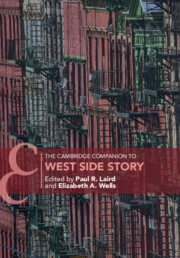Book contents
- The Cambridge Companion to West Side Story
- Cambridge Companions to Music
- The Cambridge Companion to West Side Story
- Copyright page
- Contents
- Figures
- Music Examples
- Contributors
- Preface
- Acknowledgements
- Part I Before West Side Story
- Part II The Work Itself and Its Context
- 7 The Score
- 8 Un-Gendering ‘Somewhere’
- 9 Shakespeare in the City
- 10 West Side Story and the Hispanic Problem
- 11 West Side Story and the Intersections of Class, Colourism, and Racism
- 12 The Real Gang History of New York
- Part III The Legacy
- Select Bibliography
- Index of Songs
- General Index
10 - West Side Story and the Hispanic Problem
from Part II - The Work Itself and Its Context
Published online by Cambridge University Press: 09 January 2025
- The Cambridge Companion to West Side Story
- Cambridge Companions to Music
- The Cambridge Companion to West Side Story
- Copyright page
- Contents
- Figures
- Music Examples
- Contributors
- Preface
- Acknowledgements
- Part I Before West Side Story
- Part II The Work Itself and Its Context
- 7 The Score
- 8 Un-Gendering ‘Somewhere’
- 9 Shakespeare in the City
- 10 West Side Story and the Hispanic Problem
- 11 West Side Story and the Intersections of Class, Colourism, and Racism
- 12 The Real Gang History of New York
- Part III The Legacy
- Select Bibliography
- Index of Songs
- General Index
Summary
This chapter explores practices and trends in Hispanic representation and casting in historic productions of West Side Story, particularly the 1957 Broadway production directed by Jerome Robbins, and the 1961 film directed by Robert Wise. Representation of the Puerto Rican ‘Sharks’ has been debated from sociological and cultural studies perspectives. Casting practices showing differentiation between the characters Anita and Maria as agents–sexually and racially–along with the problem of ‘racial profiling’ of Puerto Rican characters (including ‘brown face,’ homogenous accents, hairstyles, and colour) indicate ambivalent approaches toward these roles. Subsequent productions of West Side Story, including 1980 and 2009 Broadway revivals, and the 2012 intersection in the television series Glee, reproduce these practices. The chapter also explores how recent productions, including the 2020 Broadway revival directed by Ivo van Hove and !the 2021 film remake directed by Steven Spielberg, have made efforts to positively revise casting and representation issues.
Keywords
- Type
- Chapter
- Information
- The Cambridge Companion to West Side Story , pp. 170 - 187Publisher: Cambridge University PressPrint publication year: 2025

